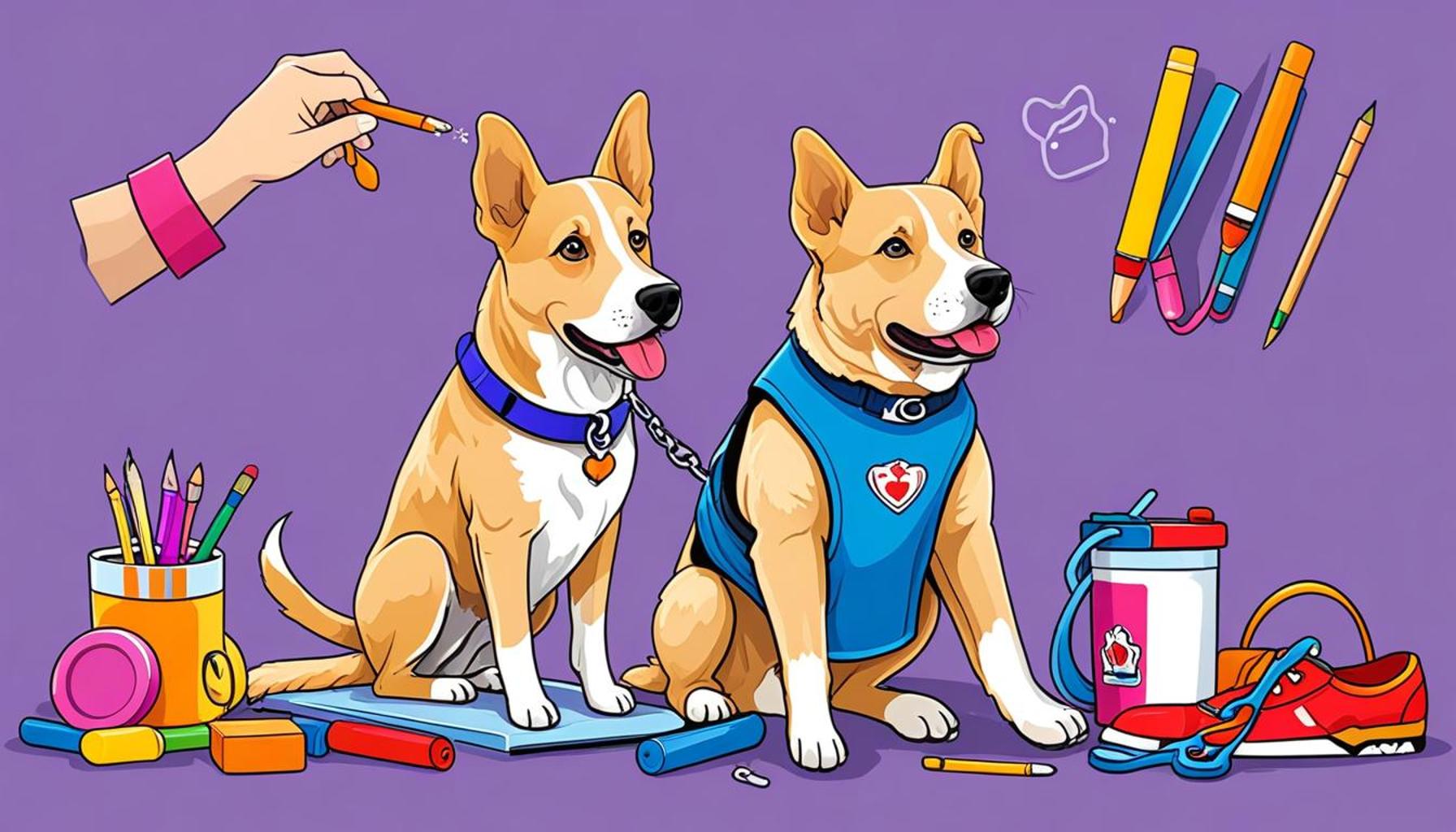Service Dog Training: Preparing for Inclusion and Accessibility

The Impact of Service Dogs on Lives and Society
Service dogs are not just canine companions; they are highly trained assistance partners that dramatically enhance the quality of life for individuals with various disabilities. The training these dogs undergo equips them to perform critical functions that facilitate inclusion and enhance accessibility, allowing their handlers to navigate everyday life with increased ease and confidence.
The relationship between service dogs and their handlers extends beyond the practical benefits; it serves to bridge gaps in societal understanding and acceptance. When individuals witness the capabilities of service dogs in public settings, it fosters a greater awareness of the challenges faced by people with disabilities, helping to challenge stereotypes and reduce stigmas. A well-trained service dog can:
- Provide emotional support, helping to alleviate feelings of anxiety and depression often associated with disabilities.
- Perform specific tasks such as retrieving dropped items, guiding visually impaired individuals, or alerting to medical conditions like seizures or low blood sugar.
- Facilitate smoother interactions in public spaces, making outings possible and enjoyable where they might otherwise be daunting.
The Importance of Quality Training
The efficacy of service dogs is contingent upon proper training, which is paramount for their safety and the safety of their handlers. Training programs play a crucial role in preparing these dogs for the complexities of public environments, ensuring that they respond appropriately to both commands and unexpected situations. A well-executed training regimen helps service dogs to:
- Ensure safety by exhibiting reliable behavior in diverse situations, from crowded shopping malls to busy public transport.
- Support social inclusion by demonstrating calmness and obedience, allowing handlers to engage comfortably with the community.
- Enhance the self-confidence of their handlers, empowering them to pursue daily activities and social interactions that might have otherwise been overwhelming.
As society increasingly embraces inclusivity, the importance of comprehensive training programs becomes ever more vital. These programs not only impart essential skills to service dogs but also contribute to creating more accessible environments for all individuals. Opportunities abound for further exploration into these training initiatives, leading one to contemplate how they reshape the fabric of community inclusion, understanding, and advocacy for individuals with disabilities.
In conclusion, the significance of service dogs extends beyond individual assistance. As communities become more aware of their role, it prompts a collective responsibility towards fostering acceptance and inclusivity, ensuring that both service animals and their handlers are fully integrated into society.

LEARN MORE: Click here to discover the importance of proper nutrition for your pet’s health
Essential Aspects of Service Dog Training
Effective service dog training requires a thoughtful and structured approach, focusing on various essential aspects that prepare these animals for their vital roles. The training process typically spans several months and involves a combination of basic obedience, socialization, and specialized tasks tailored to the needs of the handler. Each of these components is crucial in ensuring that service dogs can adapt to real-world environments and challenges.
Basic Obedience and Commands
The foundation of any successful service dog begins with basic obedience training. This stage introduces fundamental commands such as “sit,” “stay,” “come,” and “heel.” A well-trained service dog must respond promptly to these commands in a variety of situations, especially in bustling public spaces. Basic obedience ensures that the dog can remain focused on the handler, even in the face of distractions. For owners navigating crowded environments, having a dog that can reliably execute these commands is paramount for maintaining safety and composure.
Socialization with People and Other Animals
In addition to obedience training, socialization is a critical aspect of service dog preparation. Socialization involves exposing the dog to myriad environments, sounds, and people. This process helps the dog become accustomed to the various stimuli that may arise in everyday life, such as loud noises, sudden movements, or the presence of other pets. A well-socialized service dog should exhibit calmness in unfamiliar situations, allowing handlers to feel secure and confident while moving through public areas. Here are some key socialization elements:
- Introducing the dog to different environments such as parks, stores, and public transport.
- Encouraging interactions with varying age groups and personalities, including children and individuals with disabilities.
- Allowing the dog to encounter other animals in safe and controlled settings to foster positive interactions.
Specialized Task Training
Once the dog has mastered basic obedience and socialization, the next phase involves specialized task training. This aspect of training is tailored to the individual needs of the handler, depending on their unique disability. For instance, a service dog for an individual with visual impairments will need to learn guiding skills, whereas a dog assisting someone with anxiety may be trained to perform grounding behaviors during panic attacks. Some common specialized tasks include:
- Retrieving medications or necessary items, promoting independence.
- Alerting handlers to medical emergencies, such as seizures or blood sugar fluctuations.
- Providing tactile support, such as deep pressure therapy, to help alleviate anxiety.
The multifaceted approach to service dog training not only prepares these remarkable animals for their critical functions but also facilitates inclusion and enhances accessibility in society. By equipping service dogs with essential skills, the training process ultimately empowers handlers to integrate more fully into community life, enabling them to enjoy everyday activities that some may take for granted. As awareness of the importance of service dogs and their training continues to grow, communities are encouraged to consider ways to foster understanding and acceptance, paving the way for a more inclusive society.
| Category | Details |
|---|---|
| Enhanced Social Integration | Service dog training fosters better social engagement between individuals with disabilities and the community, facilitating inclusion. |
| Improved Quality of Life | Proper training allows service dogs to assist with daily needs, thus enhancing independence for their owners and alleviating personal burdens. |
The preparation for inclusion and accessibility through service dog training not only modifies the perception of disabilities in society but also creates an environment of empathy and understanding. People with disabilities often struggle to navigate public places, but the presence of a well-trained service dog can significantly alleviate these challenges. Moreover, training programs that emphasize accessibility not only teach service dogs essential tasks but also educate the public on recognizing their roles. Understanding the importance of keeping service dog areas clear allows for seamless interaction between individuals and their canine companions. This educational component is critical in cultivating an inclusive atmosphere where everyone can thrive. It encourages support and understanding from the broader community, paving the way for a society that values accessibility for all.
LEARN MORE: Click here for insights on pet nutrition
Advancing Service Dog Training Through Positive Reinforcement
A pivotal element of service dog training is the application of positive reinforcement techniques. This approach encourages desired behaviors through rewards, which can include treats, praise, or playtime. Research indicates that animals trained through positive reinforcement not only retain learned behaviors more effectively but also display increased confidence during their tasks. This correlation between training methods and success rates highlights the importance of maintaining a supportive and motivating environment.
Behavior Modification and Problem Solving
Service dogs are often faced with unpredictable situations that may require rapid adjustment of their behavior. For this reason, trainers incorporate behavior modification techniques into their programs. This helps dogs learn to handle stressors calmly and appropriately. For example, if a service dog becomes anxious during a thunderstorm, trainers might expose the dog gradually to similar sounds in a controlled setting, rewarding them for remaining calm. This practice not only aids in desensitization but also instills critical problem-solving skills that are essential in everyday scenarios.
Ongoing Training and Handler Collaboration
Training a service dog is not a one-time event; it is a continuous journey that involves ongoing reinforcement and collaboration between the trainer and handler. After the initial training, it’s essential for handlers to engage in regular practice sessions with their service dogs. These sessions not only help maintain the dog’s skills but also provide opportunities for handlers to address any issues that arise in the partnership. Handlers can work on specific tasks that suit their daily routines, ensuring the service dog remains an effective support system.
Legal Standards and Regulations
In the United States, service dogs are protected under the Americans with Disabilities Act (ADA), which outlines their rights and the responsibilities of public entities. Understanding and adhering to these legal standards is vital for both trainers and handlers alike. According to the ADA, service dogs must be trained to perform specific tasks related to a person’s disability. This serves as a driving force behind the necessity for comprehensive training programs, which should align with legal frameworks. Educational resources for trainers and handlers can often be found through organizations like the ADA National Network, which provides guidelines that promote accountability and quality training across the board.
Community Outreach and Education
As service dogs become more integrated into society, community outreach and education play crucial roles in fostering an understanding of their importance. Many organizations advocate for public awareness campaigns that highlight the functions of service dogs and the rights of their handlers. These initiatives are geared toward reducing stigma and enhancing acceptance, allowing service dogs and their owners to navigate public spaces without unnecessary obstacles. Engaging in community dialogues not only increases visibility but also cultivates a culture of inclusivity, which is essential for access and equal participation.
Striving for a more inclusive society means embracing the invaluable contributions of service dogs. By emphasizing comprehensive training that incorporates positive reinforcement, behavior modification, and fostering public understanding, we can enrich the lives of those with disabilities and promote full accessibility in everyday environments. The role these incredible animals play in supporting their handlers extends beyond mere companionship; it embodies an enduring commitment to equity and empowerment. As service dog training continues to evolve, the potential impact on individuals and communities is profound and inspiring.
LEARN MORE: Click here to discover the importance of proper nutrition for your pet’s health
Conclusion: The Path Forward for Service Dog Training
As we advance into a future that prioritizes inclusion and accessibility, the importance of effective service dog training cannot be overstated. With the foundation built upon positive reinforcement techniques, trainers are not only enhancing the capabilities of service dogs but also reinforcing their roles as crucial partners in their handlers’ daily lives. It is essential that ongoing practice and collaboration continue post-training to maintain their skillsets, ensuring they can adapt to the unique environments and challenges faced in real-world situations.
The intersection of legal standards and community outreach creates a robust framework for understanding the rights of service dog handlers and the responsibilities of the public. Educating society about the vital roles service dogs play encourages acceptance, reduces stigma, and ultimately fosters a culture of inclusivity. Engaging with community initiatives can lead to more informed spaces, paving the way for enhanced public awareness and support.
Looking ahead, the evolution of service dog training remains a promising endeavor that not only benefits individuals with disabilities but also enriches society as a whole. By embracing comprehensive training methodologies and focusing on education, we can cultivate an environment where service dogs are recognized for their invaluable contributions. As this discourse continues to unfold, the collective effort towards inclusion and accessibility will undeniably empower individuals and communities across the nation.


